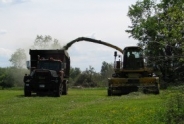Forage Quality
 Knowing when to start first cutting haycrop can be a challenge. Harvest can not be tied to a particular calendar date but instead is dependent on heat and soil moisture. Alfalfa height has proven to be the best indicator of alfalfa and grass quality in the field and can give producers a heads up as to when to harvest.
Knowing when to start first cutting haycrop can be a challenge. Harvest can not be tied to a particular calendar date but instead is dependent on heat and soil moisture. Alfalfa height has proven to be the best indicator of alfalfa and grass quality in the field and can give producers a heads up as to when to harvest.To give producers some idea of when to start harvesting first cutting, the CNY Dairy, Livestock and Field Crops Team staff measures alfalfa height on over 55 fields across the eight counties. Those locations were chosen to reflect the diversity of heat, elevation, and soil moisture found in our area.
FORAGE QUALITY CATEGORIES
1st Cutting Forage Quality Update ~ May 16, 2023
Erik Smith, Area Field Crop Specialist
Central New York Dairy and Field Crops
Last Modified: May 17, 2023
1st Cutting Forage Quality Update ~ May 8, 2023
Erik Smith, Area Field Crop Specialist
Central New York Dairy and Field Crops
Last Modified: May 9, 2023
1st Cutting Forage Quality Update ~ April 26, 2023
Erik Smith, Area Field Crop Specialist
Central New York Dairy and Field Crops
Last Modified: May 5, 2023
1st Cutting Forage Quality Update ~ May 3, 2023
Erik Smith, Area Field Crop Specialist
Central New York Dairy and Field Crops
Last Modified: May 5, 2023
1st Cutting Forage Quality Update ~ May 24, 2022
Erik Smith, Area Field Crop Specialist
Central New York Dairy and Field Crops
Last Modified: May 25, 2022
1st Cutting Forage Quality Update ~ May 17, 2022
Erik Smith, Area Field Crop Specialist
Central New York Dairy and Field Crops
Last Modified: May 18, 2022
This is our third week of monitoring 1st cutting for quality in 2022. If you are not familiar with our procedures, we use alfalfa height to predict Neutral Detergent Fiber (NDF) for alfalfa, alfalfa/grass mixed and grass stands.
1st Cutting Forage Quality Update ~ May 10, 2022
Erik Smith, Area Field Crop Specialist
Central New York Dairy and Field Crops
Last Modified: May 11, 2022
1st Cutting Forage Quality Update ~ May 3, 2022
Erik Smith, Area Field Crop Specialist
Central New York Dairy and Field Crops
Last Modified: May 5, 2022
1st Cutting Forage Quality Update ~ May 24, 2021
Erik Smith, Area Field Crop Specialist
Central New York Dairy and Field Crops
Last Modified: May 26, 2021
1st Cutting Forage Quality Update ~ May 17, 2021
Erik Smith, Area Field Crop Specialist
Central New York Dairy and Field Crops
Last Modified: May 18, 2021
1st Cutting Forage Quality Update ~ May 10, 2021
Erik Smith, Area Field Crop Specialist
Central New York Dairy and Field Crops
Last Modified: May 12, 2021
1st Cutting Forage Quality Update ~ May 3, 2021
Erik Smith, Area Field Crop Specialist
Central New York Dairy and Field Crops
Last Modified: May 5, 2021
Upcoming Events
New York State Fiber Conference
June 9, 2024
Bouckville, NY
Theme for this year: Quality Matters
Announcements
Cash Rent and Custom Harvest Survey
To date, there is limited information available about rental rates and fees for crop harvesting. Farms can use this valuable information for their farm business planning to help improve decision making and profitability.The data that is collected, and the subsequent reports/findings/resources will be helpful for all of us to answer that call of "What's the average rental rate in my area?" and "How much do people charge to combine oats?"
Farmers Can Join MeatSuite For Free!
MeatSuite.com is a free resource provided by Cornell University where NY meat farmers can create a farm profile and list their bulk (wholes, halves, quarters) and bundled (i.e. Grilling Bundle) meat products.Why should farmers join?
1. It's free and easy!
2. Connect with more local customers. In the past year the MeatSuite.com farm directory had 8,300 visits from New York consumers. Farm profiles get as many as 25 views per month from potential local customers. We also spotlight MeatSuite farms on social media and bring attention and purchases to farms through highlights and giveaways.
How do I join?
Farmers can visit https://www.meatsuite.com/farmers/ to create a free farm profile. You must list at least one product for your farm's profile to go live. You'll also have access to Cornell's free Meat Price Calculator, a helpful tool for pricing your meat to make a profit.
While you're on MeatSuite, check out the "Creating Consumer-Friendly Bulk Meats" publication on the log-in page. It has tips on how to create bulk meat products that are easier for first-time buyers to say "yes" to.
If you have any questions as you create your farm profile or products, we're here to help! Please email Matt LeRoux at mnl28@cornell.edu.





